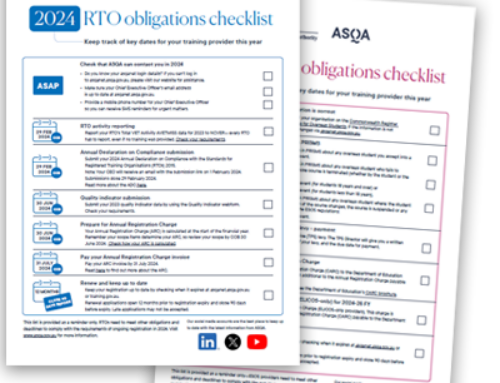Using social media to reach out to prospective students is just the next logical step in the process of building relationships. It is truly remarkable to see how far digital technology and social media have come. Ideas, news, and conversations can travel far and wide thanks to the power of digital technology and the ease of sharing via social media. Businesses can take advantage of immediacy to spread their message fast, cheaply, and efficiently.
If you want to reach your target audience and keep them engaged, you need to take advantage of social media as a marketing tool. By actively engaging with their audience on social media, educational institutions can reach an endless array of people.
Legislative requirements on marketing to international students
Registered providers must recruit responsibly and ensure that overseas students are appropriately qualified for the course they are seeking to enrol in. International students must have sufficient information to enable them to make informed decisions about studying with their chosen registered provider.
A registered provider must make information available that is comprehensive, current, and in plain English to overseas students or intending overseas students before they are enrolled.
Registered providers are required to:
- Provide comprehensive information to assist students in making informed decisions, including on course details, tuition and non-tuition fees.
- Ensure that prospective international students have sufficient English language proficiency, educational qualifications, and/or work experience to enrol in the course; and
- Have a policy and process for enrolling international students.
In addition to the standard safeguards of consumer protection, an education provider’s marketing must include:
- a clear description of the services they will provide
- the provider’s name, RTO code, and/or CRICOS code
- clear separation between nationally recognised and non-accredited training
- the NRT logo (when marketing nationally recognised training)
- accurate information about the volume of learning and amount of training required to allow them to practice new skills before they are assessed (including all activities, such as but not limited to self-directed study)
- details of any third-party arrangements, if any apply.
In summary, marketing to international students should:
- Ensure that marketing materials provide accurate and truthful information about the courses and qualifications being offered.
- Regularly review and update marketing materials to ensure compliance with government standards and guidelines.
- Avoid making false, misleading, or exaggerated claims about the outcomes of undertaking a particular course or qualification.
- Be inclusive, respectful, and considerate of the diverse needs and backgrounds of prospective students in their marketing practices.
See ASQA Fact Sheet for more information Marketing and advertising | Australian Skills Quality Authority (ASQA)
What are the objectives of social media marketing?
Using the massive audience and clout of social media sites, marketers employ social media marketing to achieve a variety of objectives. One of the most important goals is to raise brand awareness, which is when companies work to get their name out there and recognised by more people. Facilitating a community of followers and interactions via the development and maintenance of relationships with consumers and the promotion of engaging and significant exchanges.
Generating more leads and increase sales is another important goal. Providers of educational services can increase their number of paying clients by advertising on social media. The availability of quick and effective channels for customer support and feedback made possible by social media makes it an indispensable tool for customer service. Additionally, it aids companies in comprehending customer tastes and tendencies via market research, which offers useful insights.
Finally, networking and partnership opportunities presented by social media are instrumental for business growth and collaboration. Altogether, these objectives underscore the critical role of social media marketing in contemporary business strategies.
How to leverage social media
Education providers should use organic and paid social media activities to achieve three main marketing objectives:
- Support advertising efforts to recruit new students and customers and attract funding.
- Retain students and customers by creating a sense of connection and belonging.
- Increase brand awareness and engagement with your audiences.
Developing a social media strategy to engage prospective international students involves a blend of creative content, cultural sensitivity, and targeted communication. Here’s a short strategy outline with examples:
- Identify Key Platforms: Research where your target audience spends their time. For example, platforms like Facebook, LinkedIn, and Instagram are widely used globally, while others like Weibo are popular in China.
- Create Culturally Relevant Content: Tailor your content to resonate with different cultural backgrounds. For instance, post success stories of alumni from various countries, or create country-specific information sessions about the application process.
- Utilize Multilingual Posts: Offer content in multiple languages, or provide translations. For example, a welcome post in English can have versions in Spanish, Mandarin, Arabic, etc., to cater to a broader audience.
- Engage with Interactive Content: Conduct live Q&A sessions on Instagram or Facebook about studying abroad, virtual campus tours on YouTube, or interactive polls on Twitter about course preferences.
- Leverage Student Ambassadors: Use current international students as ambassadors. They can share their experiences through takeover days on Instagram or Snapchat, giving a personal perspective on student life and studies.
- Educational Webinars and Workshops: Host webinars on topics like ‘How to Apply’ or ‘Life in a ‘country’ as an International Student’. Promote these events across your social media channels.
- Partner with Influencers or Education Platforms: Collaborate with influencers in the education sector or platforms popular among students in different countries. They can share your content or create sponsored posts about your institution.
- Consistent Engagement: Regularly respond to comments and messages. This creates a sense of community and shows that you value prospective students’ inquiries.
- Use Targeted Ads: Run targeted ads on Facebook or Instagram focusing on regions you want to attract students from. Tailor the messaging of the ads to reflect the aspirations and concerns of students from those regions.
- Track and Analyze Performance: Use analytics tools to understand what type of content performs best and refine your strategy accordingly.
An example of a social media campaign:
Suppose you’re targeting prospective students from Argentina. You could organise a Facebook live event where an Argentinian student would talk about their time at your university. Concurrently, run targeted Instagram ads in Spanish and English, highlighting study opportunities or programs popular among Argentinian students. Additionally, share student testimonials on Instagram stories, with subtitles in multiple languages, including Spanish, to increase relatability and engagement.
This strategy combines targeted content, cultural adaptation, and interactive elements to effectively engage with prospective international students.
Widely used social media sites for engagement with international students
- Social Networking Sites (e.g. Facebook, LinkedIn, Instagram)
- Collaborative projects (e.g. Wikipedia)
- Social publishing platforms (e.g. Twitter, Medium, Tumblr)
- Blogs and micro-blogs (Blogger)
- Bookmarking sites (e.g. Pinterest)
- Content communities (e.g. YouTube)
- Review Sites (e.g. TripAdvisor, Yelp)
Conclusion
Leveraging social media for the recruitment of international students is a strategic necessity in today’s digitally interconnected world. Social media platforms offer unparalleled reach and accessibility, making them ideal for engaging with a global audience. They provide educational institutions with the tools to create culturally relevant, multilingual content that resonates with diverse student groups, facilitating a more personalized and direct connection with prospective students.
Educational institutions can increase their visibility and appeal to prospective international students by using social media to highlight their distinctive programs, campus life, and alumni achievements. Ads that can be fine-tuned to reach certain demographics make good use of available resources, increasing the effectiveness of recruitment drives.
Essentially, in today’s world of global student recruitment, social media is a must-have tool due to its broad reach, low cost, and constant evolution.
#internationaleducation #socialmedia #internationalstudents





Leave A Comment